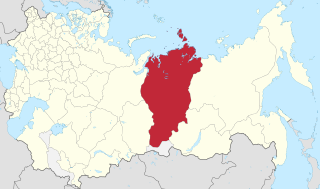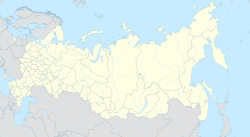
The Ob is a major river in Russia. It is in western Siberia, and with its tributary the Irtysh forms the world's seventh-longest river system, at 5,410 kilometres (3,360 mi). The Ob forms at the confluence of the Biya and Katun which have their origins in the Altai Mountains. It is the westernmost of the three great Siberian rivers that flow into the Arctic Ocean. Its flow is north-westward, then northward.

Tomsk is a city and the administrative center of Tomsk Oblast in Russia, on the Tom River. Population: 556,478 (2021 Census); 524,669 (2010 Census); 487,838 (2002 Census); 501,963 (1989 Soviet census).

Tomsk Oblast is a federal subject of Russia. It lies in the southeastern West Siberian Plain, in the southwest of the Siberian Federal District. Its administrative center is the city of Tomsk. Population: 1,047,394.

The early history of Siberia was greatly influenced by the sophisticated nomadic civilizations of the Scythians (Pazyryk) on the west of the Ural Mountains and Xiongnu (Noin-Ula) on the east of the Urals, both flourishing before the common era. The steppes of Siberia were occupied by a succession of nomadic peoples, including the Khitan people, various Turkic peoples, and the Mongol Empire. In the Late Middle Ages, Tibetan Buddhism spread into the areas south of Lake Baikal.
Kolpashevo is a town and the administrative center of Kolpashevsky District in Tomsk Oblast, Russia, located on the Ob River. Population: 24,124 (2010 Census); 28,441 (2002 Census); 31,319 (1989 Soviet census).

The Selkup are a Samoyedic speaking Uralic ethnic group native to Siberia. They live in the northern parts of Tomsk Oblast, Krasnoyarsk Krai and Tyumen Oblast. Selkups from 1850s until the 1930s exclusively in the scientific literature were called Ostyak-Samoyeds. This ethnonym has never been widely used.

Beryozovo is an urban locality and the administrative center of Beryozovsky District of Khanty-Mansi Autonomous Okrug, Russia, located on the Ob River. Population: 7,287 (2010 Census); 7,085 (2002 Census); 7,573 (1989 Soviet census).

Kolyvan is an urban locality and the administrative center of Kolyvansky District of Novosibirsk Oblast, Russia, located on the Ob River 40 kilometers (25 mi) to the north of Novosibirsk. Population: 11,842 (2010 Census); 10,947 (2002 Census); 10,589 (1989 Soviet census).

Turukhansk is a rural locality and the administrative center of Turukhansky District of Krasnoyarsk Krai, Russia, located 1,474 kilometers (916 mi) north of Krasnoyarsk, at the confluence of the Yenisey and Nizhnyaya Tunguska Rivers. Until 1924, the town was known as Monastyrskoye, and from 1924 to 1930 as Novo-Turukhansk.

Verkhoturye is a historical town and the administrative center of Verkhotursky District of Sverdlovsk Oblast, Russia, located in the middle Ural Mountains on the left bank of the Tura River 306 kilometers (190 mi) north of Yekaterinburg. Population: 8,820 (2010 Census); 7,815 (2002 Census; 8,973 ; 10,900.

The Russian conquest of Siberia took place during 1581–1778, when the Khanate of Sibir became a loose political structure of vassalages that were being undermined by the activities of Russian explorers. Although outnumbered, the Russians pressured the various family-based tribes into changing their loyalties and establishing distant forts from which they conducted raids. It is traditionally considered that Yermak Timofeyevich's campaign against the Siberian Khanate began in 1581. The annexation of Siberia and the Far East to Russia was resisted by local residents and took place against the backdrop of fierce battles between the Indigenous peoples of Siberia and the Russian Cossacks, who often committed atrocities against Indigenous Siberians.

Alexandrovsky District is an administrative and municipal district (raion), one of the sixteen in Tomsk Oblast, Russia. It is located in the northwest of the oblast and borders with the territory of Strezhevoy Town Under Oblast Jurisdiction, with Kargasoksky District, and with Khanty–Mansi Autonomous Okrug. The area of the district is 30,160 square kilometers (11,640 sq mi).} Its administrative center is the rural locality of Alexandrovskoye. Population: 8,686 ; 10,136 (2002 Census); 11,356 (1989 Soviet census)—the second least populated in Tomsk Oblast. The population of Alexandrovskoye accounts for 83.0% of the district's total population.

Yeniseysk Governorate was an administrative-territorial unit (guberniya) of the Russian Empire, the Russian Republic, and the Russian SFSR in 1822–1925. It was named after Yeniseysk.

German National District is an administrative and municipal district (raion), one of the fifty-nine in Altai Krai, Russia. It is located in the northwest of the krai. The area of the district is 1,450 square kilometers (560 sq mi). Its administrative center is the rural locality of Galbshtadt. Population: 17,668 (2010 Census); 20,598 (2002 Census). The population of Galbshtadt accounts for 9.9% of the district's total population.

Kargasok is a rural locality and the administrative center of Kargasoksky District of Tomsk Oblast, Russia, located on the left bank of the Ob River, 460 kilometers (290 mi) from Tomsk, the administrative center of the oblast. Population: 8,127 (2010 Census); 8,547 (2002 Census); 8,450 (1989 Soviet census).
Skewbald Horde was a Selkup tribal association in the basins of the Narym and Tom Rivers during the 16th century. It was an ally and eastern neighbor of the Khanate of Sibir.

Tomsk Governorate was an administrative-territorial unit (guberniya) of the Russian Empire, the Russian Republic, and the Russian SFSR, which existed from 1804 to 1925 as part of Siberian Governorate-General (1804–1822) and West Siberian Governorate-General (1822–1882). Its capital was in Tomsk.

Molchanovo is a rural locality and the administrative center of Molchanovsky District, Tomsk Oblast, Russia. Population: 5,746 (2010 Census); 6,091 (2002 Census); 6,411 (1989 Soviet census).
The Piebald Horde is the Russian term for a confederation of Selkup and Ket tribes in the Ob and Tom river basins which existed in the 16th century, in what is called the Narym region. It was the eastern neighbor and ally of the Khanate of Sibir. As Russian encroachment became a bigger threat, Piebald found itself in conflict with some of the Ugrian Khanty principalities that had allied itself with the Grand Duchy of Moscow, and later the Tsardom of Russia, namely the Principality of Kod.

The Samus culture is an Early Bronze Age archaeological culture, around 2000 BC. It was widespread in Tomsk-Narym Basin Southern Western Siberia, on the middle Irtysh and in the upper reaches of the Ob and showed close ties to the neighboring Krotov culture.




















